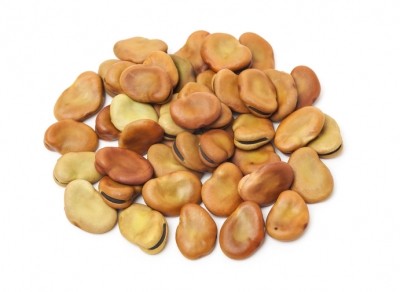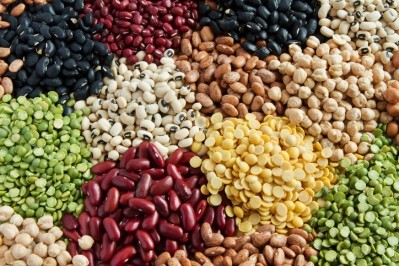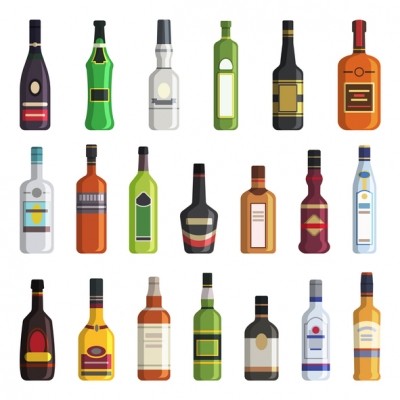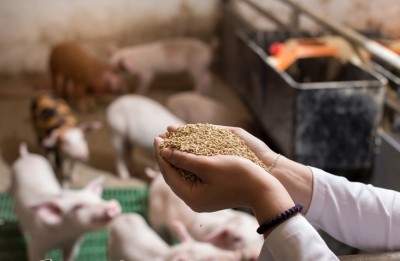Pea gin promise for dairy feed
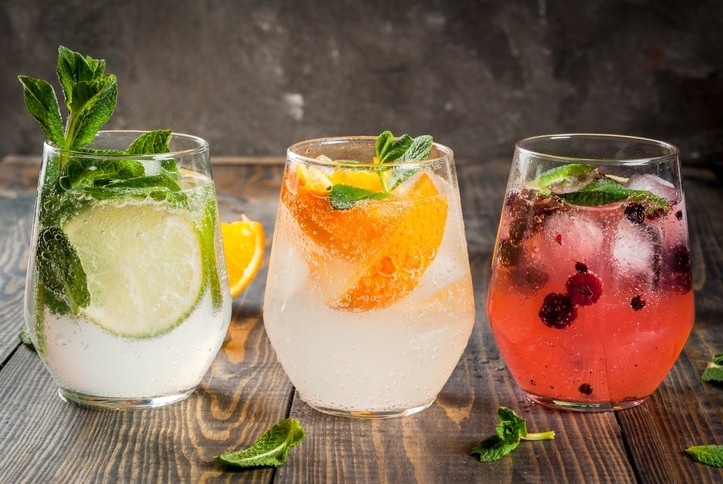
Their project is supported by the EU funded program, TRansition paths to sUstainable legume based systems in Europe (TRUE), run by the James Hutton Institute in Scotland.
The researchers carried out a life cycle assessment (LCA) comparing the environmental footprint of one liter of packaged gin produced from either 1.43kg of wheat grain or 2.42kg of peas via fermentation and distillation into neutral spirit. The LCA was based on a study on operational data provided by Arbikie distillery from the records it generated during routine operations producing conventional wheat-gin and during pilot trials for pea-gin production.
Gin production provides a pertinent case study, as it is a high-value product subject to rapidly increasing demand globally. In 2017, 377 million liters of gin were produced by the eight largest gin brands, said the researchers, citing Statista, 2019 as their data source.
Pea gin has a larger land footprint than wheat gin, depending on rotation effects, they found. However, the team argues that the supply of animal feed co-products and their use in livestock production could offset the carbon footprint of pea gin.
We spoke to Dr David Styles, lecturer in life cycle assessment, School of Environment, Natural Resources and Geography, Bangor University, to hear more about the project.
“TRUE is looking at legumes as underutilized crops within Europe, where there is only 1.5% of land area under these crops compared to about 25% in Canada, and other areas. Meanwhile, we also have a very high dependence on plant protein imports from South America, largely in soybeans. A big aim of the TRUE project is trying to find ways of becoming more self-sufficient within Europe for plant protein supply, both directly for human consumption but also for replacing animal feed,” he said.
And that is where this gin study came in.
“Although we are essentially drinking the fermented peas, in the starch fraction there is a protein rich co-product that is especially good at replacing soybeans in animal feed. It is only when you consider using this concentrated protein in the co-product, as an animal feed, that you see the full benefit of using peas instead of wheat as a feedstock for gin production.”
There is no limitation for gin in terms of feedstocks, compared to whiskey, for example.
“Gin can be made from any number of feedstocks. You can make it from wheat, potatoes or any other starchy crops, so peas would be an alternative that wouldn’t affect the flavor, because it is distilled a couple of times, it is a neutral spirit, and then it is flavored in a final distillation with botanicals. The flavor shouldn’t be affected by the composition of the starch in the fermentation process at the beginning," he said.
In terms of the trigger for the LCA, Kirsty Black, bases at Arbikie Distilling, is doing a PhD on distilling and using novel feed crop products, he said. She had carried out pilot scale pea gin production research, and the data generated allowed Styles and his colleagues to determine how much protein was left over in the co-product.
“We joined up [with her], and made [her proof of concept work] one of the case studies in the TRUE project by looking at the full life cycle impact of producing pea gin.”
Protein-rich co-product for feed
The protein-rich co-product for feed is the pot-ale produced during the fermentation stage.
“The readily available starches are broken down into sugars and fermented into alcohol and that leaves over a lot of the fibers and the protein - you get a very liquidly kind of residue from the first fermentation, that contains quite a bit of solid matter, and that is where the protein is.
“I know some breweries that transport that liquid waste to neighboring farms for cattle to feed off. Obviously, you can’t do that over longer distances, and that is where some processing investment is needed. Distilleries might not be able to afford to that on their own; if there are a number of distilleries in an area they could share investment in a facility that dries off the co-product into pellets that could be use and distributed more widely for use in animal feed.”
Styles reckons the co-product would be a valuable high protein feed product for dairy cattle, and it would be quite distinct from DDGS from alcohol production for use in feed due to its high content level.
Feeding trials could be helpful in this respect: “There would be a merit in seeing how available pea protein is and how much soybean meal it could replace in a ration or a blended mix of feed.”
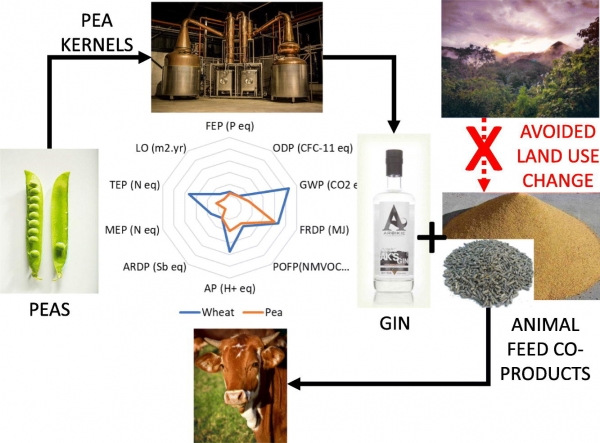
Looking at the whole picture
Legumes are challenging to cultivate, particularly in terms of yields.
“I think that is one of the reasons they aren’t widely grown in Europe. Revenue is a bit more uncertain, they are a bit more variable in their yields. That is one aspect that the TRUE project is looking at, pulling together the data to show to what extent that is the case. But, also, some of their benefits in terms of fitting into rotations are important. They might benefit subsequent crops by providing more nitrogen but also acting as break crops, helping to boost the yields of the other cereals in the rotation. And that is one of the ideas of the project, looking at whole rotation effects of introducing legumes, not just the crops themselves, which might have marginal returns in any given year, but [weighing up] all the benefits of integration of these crops into rotations," commented Styles.
Mitigating carbon footprint of pea gin
The researchers saw that more land use is required for pea gin production than for the wheat variety.
“The yields are that much lower than in wheat. But that [negative aspect] is partially offset by the increased protein content in the co-product, which avoids land use in Brazil and Argentina and those countries producing soybeans, so you get an additional credit there, but it is still not enough to compensate for the additional land you need in the first place in Europe.”
However, the team only looked at peas as one crop in the rotation; they did not look at the total rotation effects, he explained.
“And that is something we are beginning to do now in the project. We are looking at typical, existing rotations and how peas and other legumes might be integrated into them. When we do that, we will see the net productivity of these rotations before and after the introduction of legumes. That might somewhat compensate for the extra land area needed for pea gin because, arising from the integration of peas and other legumes, we would expect to see things like break crop effects and enhanced yields in subsequent crops from reducing pest incidences and putting more organic nitrogen into the soil.”
In terms of other mitigation factors, peas could potentially be cultivated on ecological focus areas (EFAs) as you do not have to add fertilizers to them, whereas cereals couldn’t be. “So that is one way peas can fit into a farm landscape without displacing cereal crops.”
Source: Environment International
DOI: https://doi.org/10.1016/j.envint.2019.05.064
Title: Just the tonic! Legume biorefining for alcohol has the potential to reduce Europe's protein deficit and mitigate climate change
Authors: T. Lienhardt, K. Black, S. Saget, M. Porto Costa, D. Chadwick, R.M. Rees, M. Williams, C. Spillane, P.M. Iannetta, G. Walker, D. Styles
